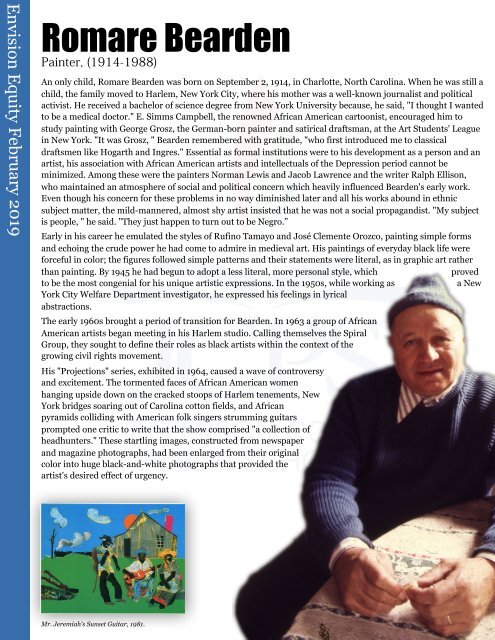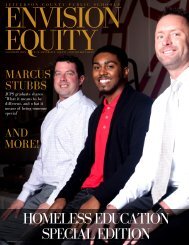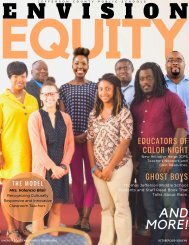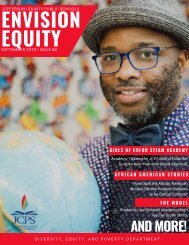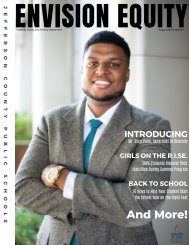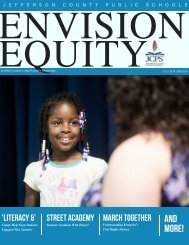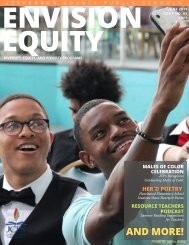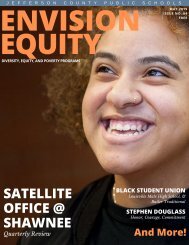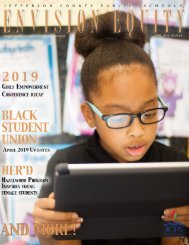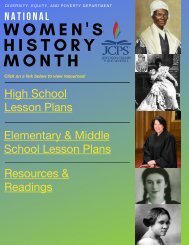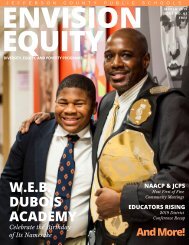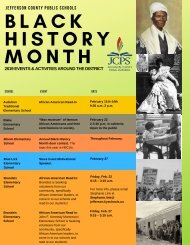Envision Equity February 2019 Special Black History Month Edition
Envision Equity February 2019 Special Black History Month Edition
Envision Equity February 2019 Special Black History Month Edition
You also want an ePaper? Increase the reach of your titles
YUMPU automatically turns print PDFs into web optimized ePapers that Google loves.
<strong>Envision</strong> <strong>Equity</strong> <strong>February</strong> <strong>2019</strong><br />
Romare Bearden<br />
<br />
<br />
An only child, Romare Bearden was born on September 2, 1914, in Charlotte, North Carolina. When he was still a<br />
child, the family moved to Harlem, New York City, where his mother was a well-known journalist and political<br />
activist. He received a bachelor of science degree from New York University because, he said, "I thought I wanted<br />
to be a medical doctor." E. Simms Campbell, the renowned African American cartoonist, encouraged him to<br />
study painting with George Grosz, the German-born painter and satirical draftsman, at the Art Students' League<br />
in New York. "It was Grosz, " Bearden remembered with gratitude, "who first introduced me to classical<br />
draftsmen like Hogarth and Ingres." Essential as formal institutions were to his development as a person and an<br />
artist, his association with African American artists and intellectuals of the Depression period cannot be<br />
minimized. Among these were the painters Norman Lewis and Jacob Lawrence and the writer Ralph Ellison,<br />
who maintained an atmosphere of social and political concern which heavily influenced Bearden's early work.<br />
Even though his concern for these problems in no way diminished later and all his works abound in ethnic<br />
subject matter, the mild-mannered, almost shy artist insisted that he was not a social propagandist. "My subject<br />
is people, " he said. "They just happen to turn out to be Negro.”<br />
Early in his career he emulated the styles of Rufino Tamayo and José Clemente Orozco, painting simple forms<br />
and echoing the crude power he had come to admire in medieval art. His paintings of everyday black life were<br />
forceful in color; the figures followed simple patterns and their statements were literal, as in graphic art rather<br />
than painting. By 1945 he had begun to adopt a less literal, more personal style, which<br />
proved<br />
to be the most congenial for his unique artistic expressions. In the 1950s, while working as<br />
a New<br />
York City Welfare Department investigator, he expressed his feelings in lyrical<br />
abstractions.<br />
The early 1960s brought a period of transition for Bearden. In 1963 a group of African<br />
American artists began meeting in his Harlem studio. Calling themselves the Spiral<br />
Group, they sought to define their roles as black artists within the context of the<br />
growing civil rights movement.<br />
His "Projections" series, exhibited in 1964, caused a wave of controversy<br />
and excitement. The tormented faces of African American women<br />
hanging upside down on the cracked stoops of Harlem tenements, New<br />
York bridges soaring out of Carolina cotton fields, and African<br />
pyramids colliding with American folk singers strumming guitars<br />
prompted one critic to write that the show comprised "a collection of<br />
headhunters." These startling images, constructed from newspaper<br />
and magazine photographs, had been enlarged from their original<br />
color into huge black-and-white photographs that provided the<br />
artist's desired effect of urgency.<br />
Mr. Jeremiah's Sunset Guitar, 1981.


